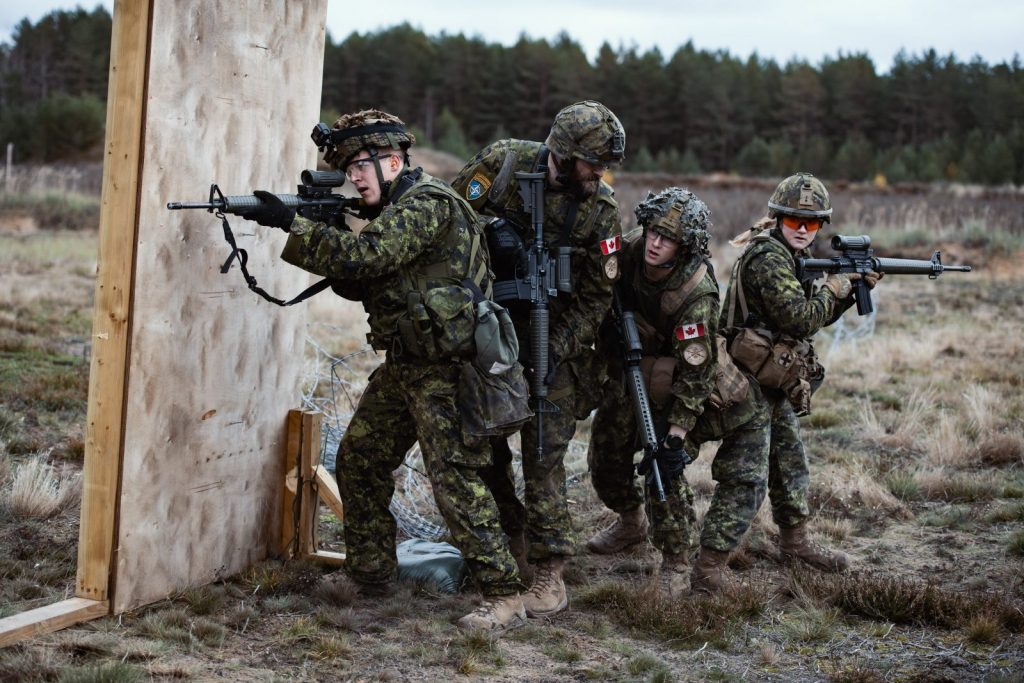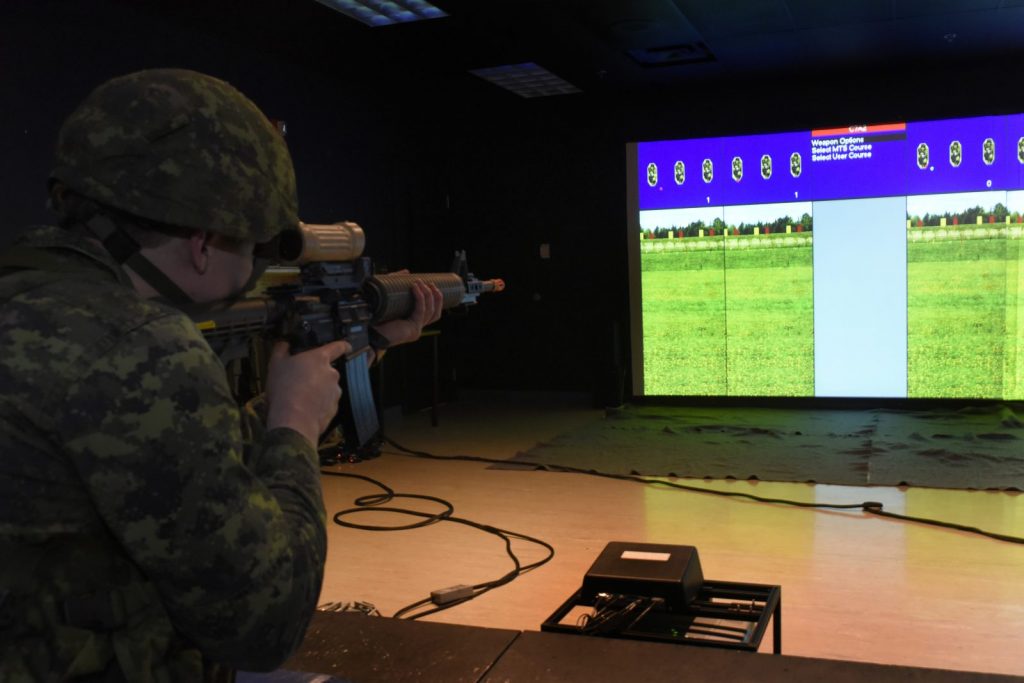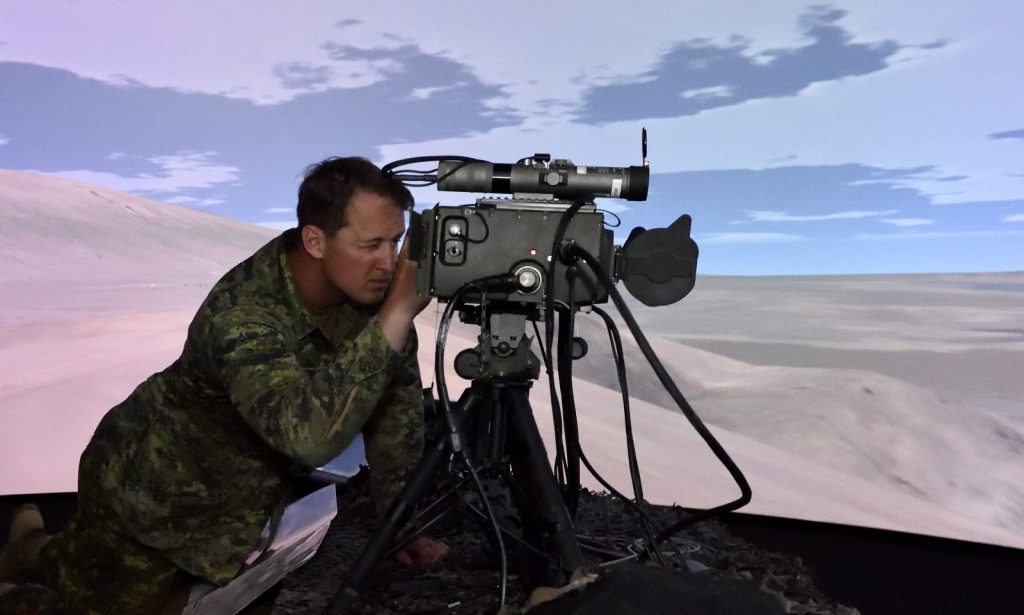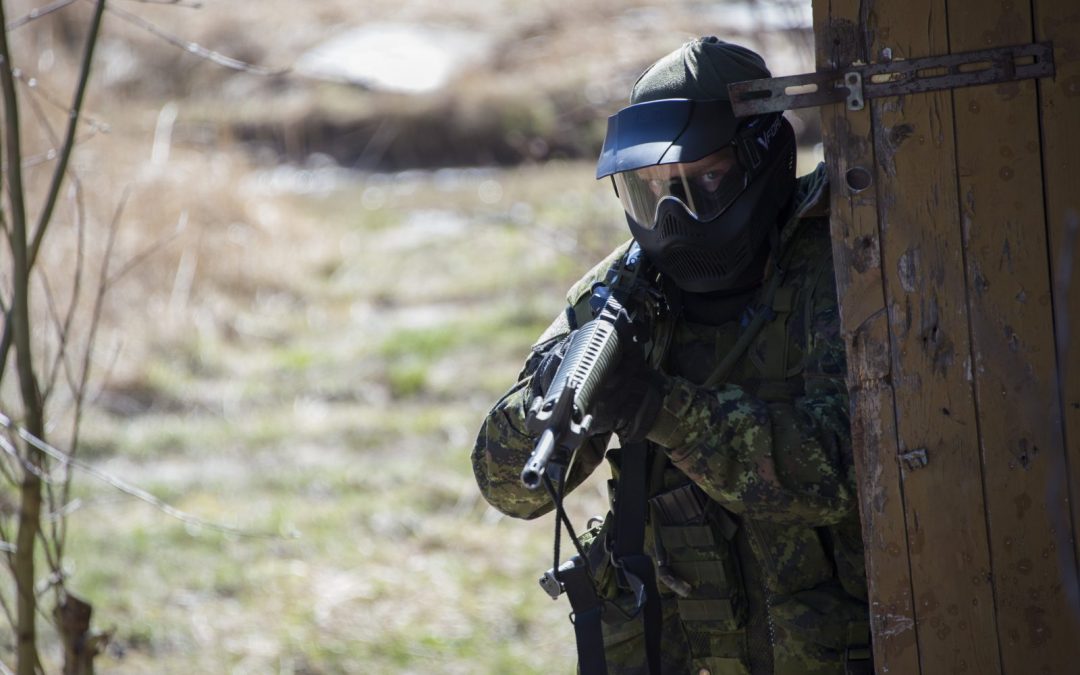by Chris Thatcher
In the not-too-distant future, when Army equipment projects seek approval from the Defence Capability Board or other governance bodies, they may have to pass a FITE test.
Fear not project directors, this won’t be an assessment of how many push ups, chin ups and sit ups your project team can muster. Rather, it would be a check to ensure that the vehicle or even individual piece of soldier equipment can integrate relatively seamlessly into the training environment.
Developed by the Canadian Army Doctrine and Training Centre (CADTC), the Future Integrated Training Environment, or FITE (pronounced fight), is a working concept for how the Army hopes to harness existing and emerging modelling and simulation technologies and design a framework for live, virtual and constructive training.
With a number of large training-related projects now moving through the procurement process, from Land Crew Vehicle Training System (LVCTS) to Urban Operations Training System (UOTS), Unit Weapons Training System, and a midlife upgrade of the Weapons Effects Simulation (WES-MU) system, the Army needed a centrally managed strategy to design the future network architecture and provide guidance to project teams on how to incorporate training system requirements into their specifications.
“We are seeing a lot of projects that have been on the books, for literally decades in some cases, having a chance to come to fruition,” said Major-General Steve Cadden, commander of CADTC. “We recognized the need for an overarching framework that would allow us to pull together the various projects and give our direction to the elements in the department responsible for procurement as well as industry to indicate what we wanted.”
“By giving them a common and coherent vision as to where they should fit into the training, it gives them direction of where they need to go,” explained Major John Gillen, the FITE lead with CADTC. “No system is an island. They have to talk, and the more things have in common, the easier it will be to talk.”
Historically, the training component of new equipment has been stove-piped, a tailored solution to a platform or weapon, often bolted on once the acquisition process was well underway and not easily integrated with other training systems. Furthermore, some systems carry high overhead costs and run on closed networks, confined to the infrastructure of facilities at Army bases.
With an “integrated procurement” approach, CADTC wants to capitalize on the planned introduction of a future Virtual Training and Experimental Network (VTEN) that will eventually tie together the training infrastructure of bases across the country by urging the development of common software and hardware standards and protocols.
CADTC also wants to buy once. As the FITE document notes, projects like Small Arms Trainer replacement, Joint Terminal Attack Controller (JTAC) trainers and Indirect Fire training systems may be managed separately, but they are likely to incorporate the same hardware such as weapons, radios and range finders, and the same terrain software. “Rather than procure each of the same elements three times through three separate procurement projects, integrated procurement would allow the reuse of a single terrain database and a single software engine on the same network.”
Changes in technology might be the primary driver for FITE, but the concept is also a consequence of the complexities of the contemporary operating environment and the need to train how the Army will fight. A networked system of live, virtual and constructed elements will offer a far more realistic experience of combat, simulating the challenges presented by urban and hybrid warfare, joint fires, electronic and cyber warfare, psychological warfare and information operations. Noted Gillen: “Those things are interacting together.”
“FITE is a description of the environment and the types of things and characteristics we want to have in our future training capabilities,” said Cadden.

Soldiers with enhanced Forward Presence Battle Group Latvia conduct a quick shoot exercise during Exercise Urban Reaper as part of Operation Reassurance in October 2019. Photo: Cpl Djalma Vuong-De Ramos
WES, MEET MILES AND TES
The concept has been a work in progress for the past two years, and draws extensively on the experience of allies. The G5 Army Training Authority is an American and Gillen, the G5 simulation officer, is a British Royal Artillery officer on a two-year exchange.
Working with project directors and through a multinational working group known as Modelling, Instrumentation and Simulation for Training Systems (MIST) under the ABCANZ (America, Britain, Canada, Australia and New Zealand) framework, the FITE team has been circulating the concept and gathering feedback on the development of standards.
The Army has been “talking interoperability for years,” noted Cadden, “[But] it has been technical interoperability. And we have finally come to the realization that it starts at the beginning phases of a project as we devise all the coding and architecture to allow systems to talk to each other.
“Our start point for any project, regardless of what the end product looks like, will be to ensure interoperability with all of our ABCANZ partners. I think we are probably about 20 years away from fully interoperable systems – at least a full procurement cycle. But we are all at least establishing the technical agreements: If we are going to get something, here is what it has to be able to do to converse with other systems.”
If LVCTS is the backbone of the various simulation training projects—a generational leap in simulation that will network combat vehicle simulators at five training bases across the country—then WES MU is the crown.
“WES MU will be where it all comes together,” explained Gillen. “The intent is to link the LVCTS locations, but the linkage with WES is where you are going to get the bang for the buck, where you are going to leverage the capability. You can really saturate the training environment if you have a brigade training and you can bring in virtual and constructive, including Reserve components.”
At present, the Cubic Global Defense WES system allows the simulation of weapons effects on soldiers and combat vehicles during collective exercises; think an elaborate game of laser tag. Though it has commonality with similar systems used by the U.S. (Multiple Integrated Laser Engagement System or MILES) and the U.K. (Tactical Effects Simulation or TES), each is a bespoke system that doesn’t share the same functionality when connected.
“The Americans use their MILES system as a way to inflict – and measure – simulated vehicle and personnel casualties on the battlefield,” said Cadden. “Our WES system does this, but with significantly more data. Our WES system can tell you exactly that rifleman No. 2 shot over here at this time and here is what he hit and the type of injury it would have caused. Two completely different levels of fidelity. But we can adjust WES so that it can receive the proper parameters for a MILES laser and go on an exercise using both, and have a rudimentary level of simulation interoperability. At present, making the two systems compatible means losing much of the added fidelity that WES is capable of. We hope to ensure in the future that our systems are compatible while preserving the additional fidelity inherent in WES.”
The WES upgrade, a project valued at up to $499 million that is currently in the options analysis phase, aims to address that so that allies can integrate at the same level of fidelity, but also so WES and LVCTS can operate on the same network, allowing live and virtual soldiers and vehicles to interact from different locations.
In fact, Cadden suggested WES might become “something that we stop issuing for a training exercise and become part of our standard equipment, with a training mode and an operational mode. That way we use our actual weapons; we don’t have to bolt on additional weight and signals. We can literally train as we fight; where we can turn on the receptors to get all the data or turn off because we are fighting. That is the concept where we need to go.”
Rather than being prescriptive, though, the Army is looking to industry to bring forward solutions that are not limited by proprietary black boxes to make that happen. CADTC wants an open architecture and the ability for soldiers to easily operate the systems.
“We want to avoid being locked into bespoke systems that are often so complex that we have to hire external contractors to run them for us,” said Cadden. “The end state for me is to have a sergeant go out with his section and do a simulated exercise without us having to book through any sort of contractor. He or she can say, ‘we’re going into the Small Arms Trainer (SAT), the scenario is in the Arctic so it will be cold, put on your mukluks’, and turn the key.”
That level of training would also apply to the Reserves. As facilities are upgraded through an infrastructure renewal initiative, Reserve units would be able to integrate virtually with Regular Force counterparts on the network without leaving the local armoury. FITE has assessed the question: “How is this going to work for a Reserve unit that does not have a top-secret facility manned 24/7,” said Cadden. “How are we going to integrate them so they can just log in to this network and take full advantage? That is a bit of a mindset and something we want to build in from the start. It will increase the upfront costs, but it will give us a huge payoff.”

Soldiers from 36 Canadian Brigade Group compete in an annual 36 CBG Soldier Skills Competition at 5 Canadian Division Training Centre Detachment Aldershot. Photo: DND
MONEYBALL FOR SOLDIERS?
With networked and fully instrumented training systems comes an abundance of data about both individual and collective performance. Like the big data analytics movement that has revolutionized how professional athletes are assessed and valued, more performance metrics could dramatically change how training is conducted.
“We are at the point where we can take out tablets and say, ‘here is what you looked like in the attack position, here is what you did when you rolled through,’ and vehicle crews can get a visual picture as opposed to just what the gunner was seeing on his screen,” observed Cadden. “That data gives us possibilities that I never think of but a young sergeant will.”
One of CADTC’s goal is a better level of data that can ensure systems like the Small Arms Trainer (SAT) are optimized so that soldiers master a skill like marksmanship before live-firing on a range. At the moment, the SAT is part of training, but without the mandatory performance expectations.
“I want them to maximize and get 100 percent on the SAT before we go to the range, so they are refining what they already know as opposed to experiencing it for the first time,” he said.
As a young tank squadron commander, he needed “a good week and half with my squadron on the basic things before we got into the more advanced training. I want to do most of that lower level stuff in simulation now, so that when we get to the field, we start right off at the more complex levels and bring in combined arms.”
Greater use of simulation won’t mean less training or cost savings, a frequent misperception. “But if we can come out [of the sim] hitting 90 percent accuracy instead of 40 percent, and spend less time making adjustments, we can bring our game up about six notches without significantly increasing the resources needed.”
Individuality and creative problem-solving is encouraged in commanders, but this will not extend to choosing whether or not to employ simulation systems, said Cadden. “To justify the really large investment we make in simulation, it is my remit to make sure we put in place the rules that say you are now going to use it and we are going to be able to measure the effects.”
But the ability to repeat individual skills and collective scenarios in a simulator should also encourage a greater willingness to accept failure, noted Gillen. “It provides a framework in which failure isn’t a catastrophe, it is a mechanism to teach.
“[FITE] it is about getting soldiers to the start line for live training at a much higher level. It is not about reducing live training, it’s about making it better and more complex and realistic,” he added.
As with athletes, a newfound deluge of individual training data might reveal unrecognized value, but its collection is nonetheless problematic, Cadden acknowledged. “We can do a lot of biometrics if we want to. Do we want to see who actually keeps his cool in the middle of a combat team attack? Whose heartbeat stays down versus who is panicking? We could track heartbeat, perspiration, sleep, hydration, and provide feedback and advice to soldiers: ‘You are getting dehydrated, drink some water.’
“But the Army is still discussing where we want to go with data collection and ethics and privacy issues that surround it. How do we protect it? Do we scrub it so it is not identifiable to an individual? There is a whole new world of data possibilities opening up for us that people are dealing with. We have the ability to go there, we just need to decide how we want to do this.”

1 Royal Canadian Horse Artillery, “Z” Battery, Forward Observation Officer, Captain Andrew Curr, runs through a scenario in the Supporting Arms Virtual Trainer at Kaneohe Bay, Marine Corps Base Hawaii during Exercise Rim of the Pacific (RIMPAC) in 2014. Photo: Sgt Matthew McGregor
TRUST IN THE DATA
For the FITE concept to deliver as intended, coherent and reliable data will be paramount, a point emphasized multiple times throughout the document. That will require not only data standards for training systems, but also in-house expertise to analyze, interpret and exploit it. That doesn’t necessarily mean another Army trade, “but we recognize we are going to have to educate individuals so that we can invest in this capability,” said Cadden.
The Army will need to do so in concert with other services. The VTEN architecture will provide a CAF-wide training network, but the FITE vision will have to tie in with what the Air Force, for example, is developing for its training systems. “How is our next generation fighter jet going to play in this, because we want the Air Force to be able to sit in their hangars and participate without having to fly actual jets to support us,” he said of JTAC training. “Incorporating these types of innovations is huge and changes the game for us.”
Drafts of the document have been circulated throughout the Army, with other services and with industry, in particular companies positioning for LVCTS, which is through the definition phase and nearing request for proposals.
“People are reading through this,” he said. “We have companies proposing fully supported operations and others where we get the keys and there is no contracted support whatsoever. There are some very interesting variations from different companies on how they can provide these types of capabilities for us.”
Both Cadden and Gillen emphasized that FITE is not a procurement project with “a pile of cash.” But once gateways are established, it will be instrumental in guiding the training system requirements and standards for the vast majority of Army projects.
“FITE compliance might be too rich a term, but does [a project] fit in the FITE vision? If not, why not? Is there a good reason? Governance is really the key here,” said Gillen. “The training component of any new platform will need to go through this. Is that plan FITE-able?”



Not withstanding overall team performance, Strategic goals are achieved through the success of task level operations by single players/individuals making decisions on the “ground”. Task related outcomes are affected by how well the individual’s physiology responds physically, mentally and emotionally to the external and internal stressors impacting them during the performance of their task(s). This task could be digging a ditch, relaying communications, operating equipment or engaging the enemy among other things. This stress can cause auditory exclusion, perceptual narrowing, time distortion, awareness lapse, memory loss, loss of fine motor skills, sense of being overwhelmed, confusion, etcetera. Commanders can give orders, but when, how and if they are carried out well is determined by those in stressful situations who are possibly facing death. This type of stress is the “Z” factor. And if the Z factor can not be trained for then task objectives are at risk and can be labeled with greater unpredictability values as Stress increases. This stress therefore needs to be applied and mitigated through learning. All value added Virtual and live simulation must take into account what has been missed in the past and train their personnel to mitigate the stress affect. Only one product will work with existing systems to do that.